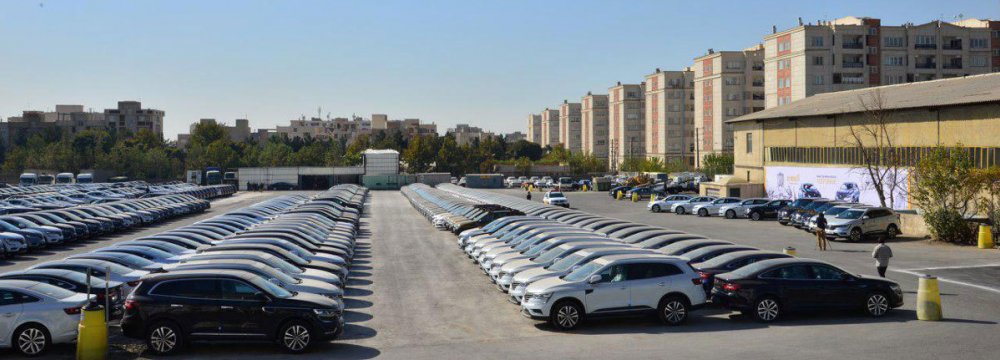
Renault, Hyundai Extending Lead in Iran Imported Auto Market

Renault’s reported 13% year-on-year increase reaching 27% of the total imports. Hyundai’s share of the market has reached 23%, though it showed a YoY decline of 7%.
According to data released by Iran’s Auto Importers Association during the period, 55,816 vehicles with the total value of $1.47 billion entered Iran indicating a 13% rise compared to the same period last year.
Imported cars have a 5.1% share of the overall car market. During the nine months local carmakers reported 17.5% increase in total output, manufacturing 1,034,881 vehicles. The numbers have created a feeling among industry observers and market experts that the local auto market soon will reach saturation point.
During the nine months the UAE with 38,412 vehicles (69%), South Korea 5,602 (10%), France 2,666 (5%), China 2,078 (4%), Turkey, 1,697 (3%) and Germany 1,662 (3%) were the main exporters of cars to Iran. The Persian Gulf Arab state (UAE) is a major trading center and a re-export hub.
The most popular imported Renault model in Iran is the company’s SUV Koleos with 4,387, followed closely by its sedan Talisman (4,161) and the subcompact crossover Captur with (3,400). Renault’s Duster and Symbol are also available in the domestic car market with 1,870 and 1,274 units of each imported respectively.
Renault’s success is partly due to the company’s expanding presence in Iran. Renault’s partner Negin Khodro has set up after-sales service centers in almost all major cities.
The French carmaker also has a trilateral joint production deal with Negin Khodro and Iran’s Industrial Development and Renovation Organization which to some extent gives the impression that the company is focusing on a long-term presence.
Hyundai Motor
While Renault claims the title of the most popular imported brand, Hyundai’s Tucson was the most successful model with 4,475 units.
According to the statistics, Hyundai’s share has declined 7% and reached 23%. The South Korean firm dominated Iran’s imported car market for several years. Currently, Hyundai is in second place. During the nine months 12,687 Hyundai cars entered the country.
After Tucson, Santa Fe (3,618), Sonata (3,294) and Elantra (1,144) are the most popular Hyundai models. The company has a production and import agreement with Kerman Motor, Iran’s second largest private car company. Kerman Motor produces and assembles three Hyundai models, namely i10, i20 and Accent in the central city of Bam, Kerman Province.
Japanese Carmakers
Two major Japanese carmakers Nissan and Toyota jointly claim the title of the third most popular imported brands, each with 9% share of the market.
During the nine-month period, 5,109 Nissan cars were imported, the bulk consisting of the small crossover Juke (3,185) and the company’s flashy SUV X-Trail (1,921). Nissan has reported 6% YoY increase in its market share.
The number of imported Toyotas is slightly below Nissan. During the period 5,043 Toyotas were imported. The company’s market share has declined 4% YoY. Toyota’s most popular models in Iran are Rav4 and Prius. According to the data 2,729 Rav4 and 1,610 units of Prius were imported. Prius has been one of the most successful hybrids in the domestic market in recent times. The model has a 27% share of Iran’s imported Hybrid cars market.
Sharpest Decline
KIA Motors share of the local market saw a sharp 11% decline reaching 6%, pushing the South Korean firm to fourth place. This is while the company up until recently was a major player in the huge car market and was the second most imported brand in 2016 and early 2017.
During the nine-month period, 4,306 cars produced by the South Korean firm were imported. The most popular Kia model was the mid-size crossover Sorento with 1,578 units, followed by Optima with 1,487.
KIA was closely followed by SsangYong Motor with 3,578 units of its mini SUV Tivoli. The company had 6% share of the market. During the period 2,931 BMWs, 2,604 Lexus and 2,185 Mitsubishis were also imported.


Trump weighs using $2 billion in CHIPS Act funding for critical minerals

Codelco cuts 2025 copper forecast after El Teniente mine collapse

Electra converts debt, launches $30M raise to jumpstart stalled cobalt refinery

Barrick’s Reko Diq in line for $410M ADB backing

Abcourt readies Sleeping Giant mill to pour first gold since 2014

Nevada army depot to serve as base for first US strategic minerals stockpile

SQM boosts lithium supply plans as prices flick higher

Viridis unveils 200Mt initial reserve for Brazil rare earth project

Tailings could meet much of US critical mineral demand – study

Kyrgyzstan kicks off underground gold mining at Kumtor

Kyrgyzstan kicks off underground gold mining at Kumtor

KoBold Metals granted lithium exploration rights in Congo

Freeport Indonesia to wrap up Gresik plant repairs by early September

Energy Fuels soars on Vulcan Elements partnership

Northern Dynasty sticks to proposal in battle to lift Pebble mine veto

Giustra-backed mining firm teams up with informal miners in Colombia

Critical Metals signs agreement to supply rare earth to US government-funded facility

China extends rare earth controls to imported material

Galan Lithium proceeds with $13M financing for Argentina project

Kyrgyzstan kicks off underground gold mining at Kumtor

Freeport Indonesia to wrap up Gresik plant repairs by early September

Energy Fuels soars on Vulcan Elements partnership

Northern Dynasty sticks to proposal in battle to lift Pebble mine veto

Giustra-backed mining firm teams up with informal miners in Colombia

Critical Metals signs agreement to supply rare earth to US government-funded facility

China extends rare earth controls to imported material

Galan Lithium proceeds with $13M financing for Argentina project

Silver price touches $39 as market weighs rate cut outlook

















